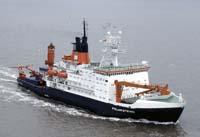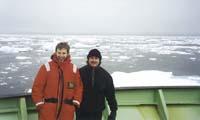Ocean fertilization

The aim of the LOHAFEX experiment is to investigate the influence of iron enrichment of the sea. In fact, some researchers have proposed that it can be a solution to combat climate change.
The researchers hypothesis is that by enriching the sea with iron increases phytoplankton. Phytoplankton, growing, takes carbon dioxide and turns it into organic matter. On the other hand, as carbon dioxide in water is in equilibrium with that of the atmosphere, as phytoplankton takes carbon dioxide, the atmosphere passes to the sea. Thus, the concentration of carbon dioxide in the atmosphere decreases. They therefore consider that the momentum of the process can be useful in combating climate change.
However, many researchers believe that marine fertilization is not a suitable solution. This is the case of AZTI-Tecnalia biologist Xabier Irigoien. Irigoien has spent years researching the influence of plankton and climate on plankton and has worked in the Antarctic area, where the LOHAFEX experiment is being conducted.
According to Irigoien, the hypothesis is based on the phenomenon HNLC ( high-nutrient, low-chlorophyll). In fact, in some areas of the sea, such as Antarctica, despite being quite macronutrient, phytoplankton grows very little. The reason is that some micronutrient is missing.
This micronutrient may be iron, or another. For example, in the Mediterranean there is an excessive proliferation of algae at the exit of the rivers, due to the discharge of phosphorus to the rivers. Agricultural fertilizers and urban and industrial detergents are the origin of this phosphorus.

Results and calculations
In any case, according to Irigoien, "the proliferation of phytoplankton does not necessarily mean a reduction of carbon dioxide in water". For this they have to pass the two things; on the one hand, phytoplankton should take carbon dioxide from the water, and that is, when it increases. But in addition, phytoplankton has to sink. For example, if microorganisms or marine animals consume phytoplankton, carbon dioxide is released again on the surface of the sea.
"In similar studies carried out already in the Antarctic and Galapagos it has been observed that the proportion that sinks from the growing phytoplankton is very small," says Irigoien. "In addition, this proportion varies greatly from place to place."
The latest published study reveals the same. The Southampton Oceanography Centre has published in the journal Nature the results of the CROZEX experiment and the conclusion is that, for each unit of iron that has sunk more than 200 meters, the amount of carbon is 80 times lower than that experienced in the Kerguel area.
The experiment was conducted in the Crozet Islands in 2004-2005, 2,000 kilometers southeast of South Africa. A second test was previously conducted in the nearby area of Kerguel and, given the results obtained, it was thought that the method could contribute in part to the reduction of carbon dioxide in the atmosphere. To a small extent, the truth. In fact, according to estimates made based on this and other studies, to eliminate 30% of the carbon dioxide emissions to the atmosphere generated by human activities in a year, an area 10 times greater than the Southeast Ocean should be treated.

However, taking into account the results of the CROZEX experiment, the ineffectiveness of the method is even more evident, since the fertilization of all the oceans of the planet would not affect the amount of carbon dioxide in the atmosphere.
An ocean of doubt
Before knowing the results of the CROZEX experiment, having not reached clear conclusions in the last fifteen years, the United Nations decided last year to suspend such experiments. The decision was made at the meeting of the Convention on Biological Diversity and was signed by 191 countries. The main reasons for interrupting the experiments were, on the one hand, that they do not know that they will have beneficial effects on the climate and, on the other, that they can be harmful.
Irigoien shares this conviction. He explains that the proportion of phytoplankton that sinks depends on many factors, such as the species that grows, since they must be large shipwrecks (diatoms, for example), they should not be eaten by others (and often the opposite happens) and the dynamics of currents should contribute to sinking.
Irigoien also mentioned another part: "Not only do we not know how much it will sink, but it will take danger." When phytoplankton increases, there are species that grow more easily than others, thus breaking the balance between species and the trophic chain. Toxic phytoplankton may also occur.

For all this, Irigoien does not believe that sea fertilization is a good solution. Companies that want to do business with it do not see them well, because "they sell that they remove carbon dioxide from the atmosphere without knowing how much they take it, because it cannot be measured." For Irigoien, other methods such as afforestation are better at achieving this: "So, at least, you can measure the carbon dioxide removed; who pays knows what it pays for."
However, contrary to the decision of the United Nations and despite the fact that Germany is one of the signatories to the Convention on Biological Diversity, the experimental LOHAFEX carried out their project. Thus, 20 tons of iron sulphates were deposited into the ocean, between Argentina and the Antarctic peninsula. Its consequences are now being studied: how much phytoplankton grows, what species, what influence it has on the ecosystem, how much it sinks... That is, aspects similar to those studied in other research carried out to date. They may expect very different results.






